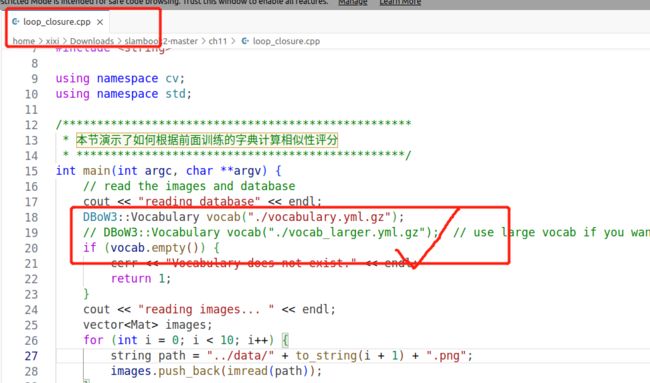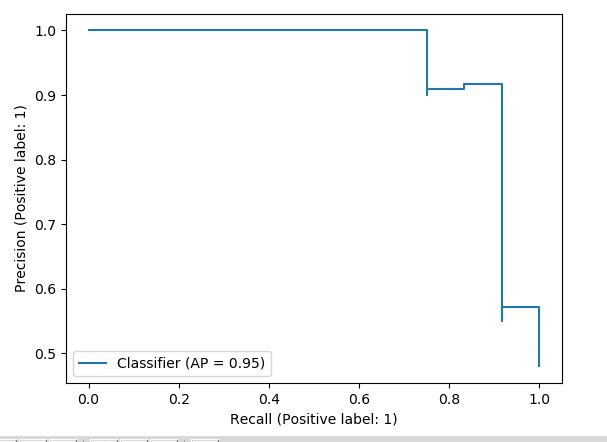《视觉 SLAM 十四讲》V2 第 11 讲 回环检测【消除累积误差】
待做:
- 习题整理
- 相关文献【新的综述】等
P283
文章目录
-
- 11.2 词袋 模型
-
- 11.3.2 Code: 创建字典
- 11.4.2 Code: 相似度 计算
-
- 训练 自己的字典 报错
- 习题
-
- √ 题1
- √ 题2
- 题3 DBoW3库
- 题4
- 题5
基于 词袋 的外观式 回环检测
SLAM主体(前端后端): 估计相机运动
前端: 提供特征点的提取 和 轨迹、地图的初值。
后端: 对所有这些数据进行优化。
视觉里程计 仅考虑相邻时间上 的 关键帧。
累积误差
全局一致 的 轨迹和地图
回环检测的关键: 如何有效地 检测出 相机经过同一个地方 这件事。
位姿图 质点 弹簧系统。提高了系统稳定性。
回环边: 把带有累计误差的边 “拉” 到了正确的位置。
估计的轨迹和地图 在长时间下 的正确性。
利用回环检测 进行 重定位。
视觉里程计: 仅有前端 和 局部后端的系统
SLAM: 带有回环检测和全局后端的系统
1、对任意两幅图像都做一遍特征匹配
- 不是所有图像都有回环
- 对于 N 对可能的回环, 要检测 C 2 N C_2^N C2N 次,复杂度为 O ( N 2 ) O(N^2) O(N2)
- 无法实时
2、随机抽取历史数据进行回环检测
- 检测效率不高
3、基于 外观 ✔
4、室外 GPS
如何 计算图像间的相似性
不选择 两幅图像相减 s ( A , B ) = ∣ ∣ A − B ∣ ∣ s(\bm{A, B}) = ||\bm{A-B}|| s(A,B)=∣∣A−B∣∣ 比较相似性 的原因:
1、像素灰度受环境光照和相机曝光的影响
2、相机视角变化,会使得像素在图像中发生位移,造成大的差异值
感知偏差(Perceptual Aliasing) 假阳性(False Positive)
感知变异(Perceptual Variability) 假阴性 (False Negative)
准确率:Precision = T P T P + F P \frac{TP}{TP+FP} TP+FPTP 判为正的正样本数/ 判为正的样本数
召回率:Recall = T P T P + F N \frac{TP}{TP+FN} TP+FNTP 判为正的正样本数/ 全部正样本数
准确率: 算法提取的所有回环中 确实是 真实回环 的概率。
召回率: 在所有真实回环中 被正确检测出来的概率。
A 在 准确率 较高时 还有很好的召回率, B在 70% 召回率 的情况下还能保证 较好的准确率。
SLAM : 准确率 要求更高
- 检测结果是 而实际不是 【假阳性】 添加错误的边有可能 导致 整个建图失效
召回率 低些 ——> 部分回环 没被检测到 ——> 累积误差 影响建图
- 一两次 回环即可完全消除。
特征匹配: 费时、光照变化会导致特征描述不稳定。
11.2 词袋 模型
Bag-of-Words(Bow) : “图像上有哪几种特征” 来描述一幅图像。
是否出现
强调的是 Words 的有无, 无关顺序。
字典生成 聚类
K-means

把已经提取的大量特征点 聚类成 一个含有 k k k 个单词的字典。
如何 根据图像中某个特征点查找字典中相应的单词
11.3.2 Code: 创建字典
ORB 特征描述
- ORB(Oriented FAST and Rotated BRIEF)特征
对10张 目标图像 提取 ORB特征 并存放至 vector 容器中,然后调用 DBoW3的字典生成接口。

————————配置环境: 开始
1、下载 DBow3
git clone https://github.com/rmsalinas/DBow3.git
2、进入 文件夹,并打开命令行窗口
3、按照 cmake 流程进行编译安装
mkdir build && cd build
cmake ..
make
sudo make install
OpenCV版本查看
python3 -c "import cv2; print(cv2.__version__)"
4.2.0
报错:
feature_training.cpp修改

这里顺便也改了。。

修改后 务必记得 cmake 一遍
cd build
cmake ..
make
./feature_training
————————配置环境: 结束
feature_training.cpp
#include "DBoW3/DBoW3.h"
#include CMakeLists.txt
cmake_minimum_required( VERSION 2.8 )
project( loop_closure )
set( CMAKE_BUILD_TYPE "Release" )
set( CMAKE_CXX_FLAGS "-std=c++11 -O3" )
# opencv
find_package( OpenCV 4.2.0 REQUIRED )
include_directories( ${OpenCV_INCLUDE_DIRS} )
# dbow3
# dbow3 is a simple lib so I assume you installed it in default directory
set( DBoW3_INCLUDE_DIRS "/usr/local/include" )
set( DBoW3_LIBS "/usr/local/lib/libDBoW3.so" )
add_executable( feature_training feature_training.cpp )
target_link_libraries( feature_training ${OpenCV_LIBS} ${DBoW3_LIBS} )
add_executable( loop_closure loop_closure.cpp )
target_link_libraries( loop_closure ${OpenCV_LIBS} ${DBoW3_LIBS} )
add_executable( gen_vocab gen_vocab_large.cpp )
target_link_libraries( gen_vocab ${OpenCV_LIBS} ${DBoW3_LIBS} )
11.4.2 Code: 相似度 计算
TF-IDF (Term Frequency-Inverse Document Frequency)
频率-逆文档频率
使用上节的字典生成词袋 并 比较差异
要改动的地方: 之前的data路径要是没改记得改

要是改了要 cmake 一遍
./loop_closure
#include "DBoW3/DBoW3.h"
#include 11.5.1
修改这里 并重新 cmake 即可
./loop_closure
把相近的回环聚成 一类。比如 第n, n-2, n-3帧
检测之后的验证:
1、回环 缓存【多次检测到相似✔】: 一段时间中一直检测到的回环,才是正确的回环
2、回环检测到的帧进行特征匹配【相应 相机位姿也匹配✔】,估计各自的相机运动,检查位姿是否出入很大。
分类
图像相似性
训练 自己的字典 报错
#include "DBoW3/DBoW3.h"
#include 习题
√ 题1
pip install -U scikit-learn
sklearn.metrics.PrecisionRecallDisplay
test.py
import matplotlib.pyplot as plt
from sklearn.datasets import make_classification
from sklearn.metrics import PrecisionRecallDisplay
from sklearn.model_selection import train_test_split
from sklearn.linear_model import LogisticRegression
X, y = make_classification(random_state=0)
X_train, X_test, y_train, y_test = train_test_split(
X, y, random_state=0)
clf = LogisticRegression() # 分类模型
clf.fit(X_train, y_train)
y_pred = clf.predict_proba(X_test)[:, 1] # 得到预测值
# 绘制 PR 曲线 需要预测结果 及 label
PrecisionRecallDisplay.from_predictions(
y_test, y_pred)
plt.show()
python3 test.py
√ 题2
2、验证回环检测算法,需要有人工标记回环的数据集。然而人工标记回环是很不方便的,我们会考虑根据标准轨迹计算回环。即,如果轨迹中有两个帧的位姿非常相近,就认为它们是回环。请根据TUM数据集给出的标准轨迹,计算出一个数据集中的回环。这些回环的图像真的相似吗?
解答链接

FAB-MAP: Probabilistic Localization and Mapping in the Space of Appearance
题3 DBoW3库
DBoW3是DBow2库的改进版本,DBow2库是一个开源c++库,用于索引图像并将其转换为词袋表示。它实现了一个层次树,用于在图像特征空间中逼近最近邻,并创建视觉词汇表。DBoW3还实现了一个图像数据库,其中包含反向和直接文件,用于索引图像,并支持快速查询和特性比较。
github链接
git clone https://github.com/rmsalinas/DBoW3.git
可参考
————————————————
题4
4、
1、欧几里得距离(Eucledian Distance)

2、曼哈顿距离(Manhattan Distance)
3、明可夫斯基距离(Minkowski distance)

4、(余弦相似度)Cosine Similarity 方向
六、皮尔森相关系数(Pearson Correlation Coefficient)

——————————————————
题5
5、Chow-Liu树:
链接1: https://web.stanford.edu/class/ee376a/files/2017-18/chow-liu.pdf
链接2【详细】:https://people.kth.se/~tjtkoski/chowliulect.pdf
Chow-Liu树是对概率分布的“最佳可能”树形信念网络逼近,使得所有边都远离根。利用真实分布与Chow-Liu树定义的分布之间的Kullback-Leibler距离来测量近似的质量。当我们从数据中学习时,“真实”分布是由观测值的频率定义的。Chow和Liu(1968)表明,最优树可以作为所有变量上的最大权值生成树,其中每条边的权值作为由边连接的变量之间的互信息给出。
Chow-Liu树可以构造如下:
1、为每一对 ( X i , X j ) (X_i, X_j) (Xi,Xj) 计算互信息 M I ( X i , X j ) MI(X_i, X_j) MI(Xi,Xj)。
2、考虑完全 M I MI MI加权图, 无向。
3、为完全 M I MI MI加权图构建最大权值生成树。
4、通过选择任何变量作为根,并将链接的方向设置为从它向外,来指导生成的树。






















